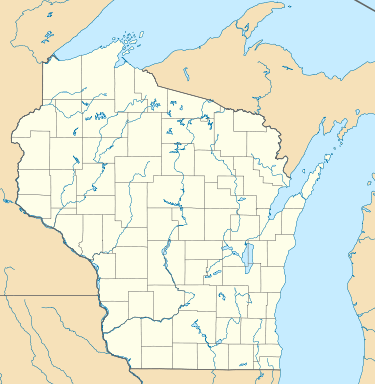Romeo and Juliet Windmill
| Romeo and Juliet Windmill | |
|---|---|
.jpg) Romeo and Juliet Windmill. Photograph by Marco 2001. | |
  | |
| General information | |
| Type | Windmill |
| Location | south of Spring Green, in Iowa County, Wisconsin |
| Coordinates | 43°08′30″N 90°04′15″W / 43.14153°N 90.07091°WCoordinates: 43°08′30″N 90°04′15″W / 43.14153°N 90.07091°W |
| Construction started | 1896 |
| Completed | 1897, 1938, 1992 |
| Design and construction | |
| Architect | Frank Lloyd Wright |
The Romeo and Juliet Windmill, is a wooden structure designed by architect Frank Lloyd Wright in the town of Wyoming, Wisconsin[1] (Wyoming is south of the town of Spring Green). It was designed in 1896 after being commissioned by Wright's aunts, Jane and Ellen Lloyd Jones, who needed the windmill to provide water for their school,[2] the Hillside Home School. The diamond-shaped portion of the windmill intersects the portion with the balcony that sits on an octagonal structure. The balcony is accessible through an interior stairway. Wright named these two parts of the building "Romeo" and "Juliet". "Romeo" is the lozenge and Juliet, the octagon. Architectural historian, Neil Levine explained the principles behind the lozenge and octagon:
[Wright] gave the tower a bold geometric form as a structural solution to the expression of the tower's role as a landmark. The pump rod and support for the wheel are carried up within an acutely angled lozenge shape pointed southeast to deflect blasts of wind like a "storm prow". This angular element is inserted halfway into a larger octagonal volume that contains and supports it throughout nearly its full height. Wright called the composition Romeo and Juliet, likening its conjugate geometry to an amorous union.[3]
After resistance from his uncles about the design,[4] Wright explained the windmill to the aunts:
Of course you had a hard time with Romeo and Juliet. But you know how troublesome they were centuries ago. The principle they represent still causes mischief in the world because it is so vital. Each is indispensable to the other... neither could stand without the other. Romeo, as you will see, will do all the work and Juliet cuddle alongside to support and exhalt him. Romeo takes the side of the blast and Juliet will entertain the school children. Let's let it go at that.[5]
According to the local Spring Green newspaper, The Home News, the windmill was completed in 1897.[6] The Romeo and Juliet Windmill was the second structure the aunts commissioned from Wright. The first one, which no longer exists, was Hillside Home School I built in 1887. It was known by students and teachers in the institution of the Hillside Home School as the Home Building.[7] The third structure designed by Wright for the Hillside Home School was a stone educational facility, the Hillside Home School II, commonly known as the Hillside Home School, since it's the only one of the two that still exists.
Romeo and Juliet is one of five buildings designed by Frank Lloyd Wright on what became his property, which is now known as the Taliesin estate. From the windmill, it is possible to see three of the other structures on the Taliesin estate: the residence Taliesin is on an adjacent hill to the north, Tan-y-Deri is near the windmill's base, and the Hillside Home School is down the hill to windmill's south. Also on the estate is the farming structure, Midway Barn.
Originally clad in shingles, the windmill was later re-clad in cypress board and batten in 1938.[8] Repairs on the windmill were attempted by its owner, the Frank Lloyd Wright Foundation and an effort on restoration was completed in 1992 by the newly formed Taliesin Preservation, Inc., which carries out restoration on the Taliesin estate with assistance from the Frank Lloyd Wright Foundation.[9] The windmill no longer pumps water.
References
- ↑ Bruce Brooks Pfeiffer, Frank Lloyd Wright Complete Works, Vol. 1: 1885-1916, Taschen, 2009, p. 154.
- ↑ The Home News, September 23, 1897, p. 3. "The waterworks at the Hillside Home have been enlarged by a reservoir of 1000 barrels capacity tunneled into the rock of Sand Hill, back of the school building.... This will give an adequate supply of water in case of fire or for irrigation."
- ↑ Neil Levine, The Architecture of Frank Lloyd Wright (Princeton University Press, Princeton, 1996), p. 82
- ↑ Frank Lloyd Wright Collected Writings: 1930-32, volume 2. Edited by Bruce Brooks Pfeiffer, introduction by Kenneth Frampton (1992; Rizzoli International Publications, Inc., New York City, 1992), p. 192-197.
- ↑ Frank Lloyd Wright Collected Writings: 1930-32, volume 2. Edited by Bruce Brooks Pfeiffer, introduction by Kenneth Frampton (1992; Rizzoli International Publications, Inc., New York City, 1992), p. 195.
- ↑ Weekly Home News, September 30, 1897.
- ↑ Mary Ellen Chase, A Goodly Fellowship (The Macmillan Company, New York City, 1939), Chapter 3, "I Seek My Fortune in the Middle West", p. 98.
- ↑ William Allin Storrer. The Frank Lloyd Wright Companion. University of Chicago Press, 2006, ISBN 0-226-77621-2 (S.367), p. 35.
- ↑ "Saving Taliesin: Preserving a Masterpiece" 88.1 WYCE March 4, 2017.